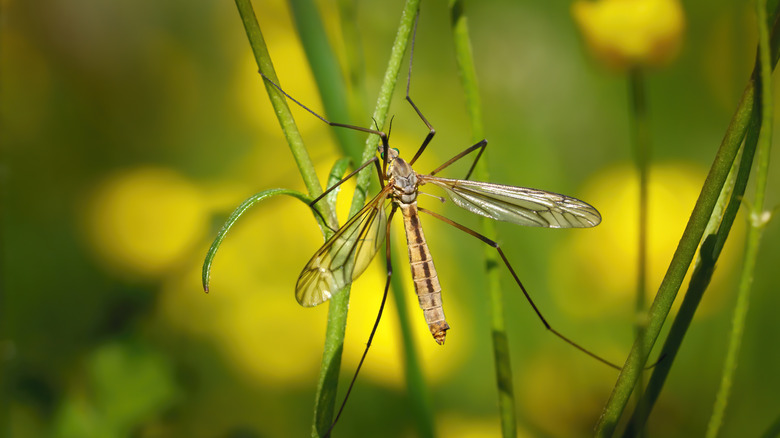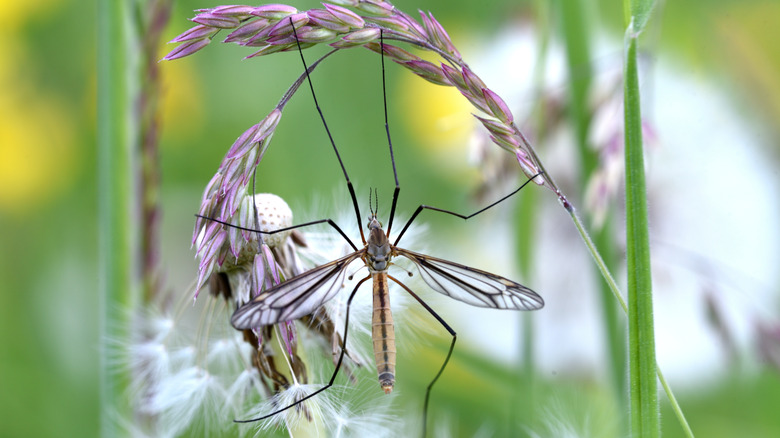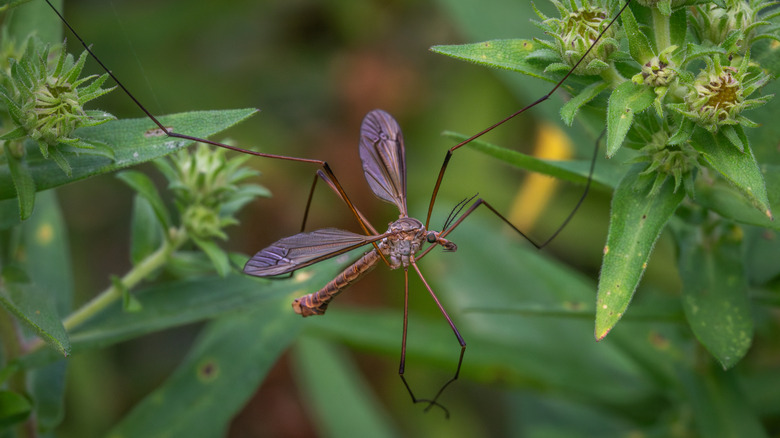What Are Those Big Mosquitoes Called?
It's a balmy Saturday evening in July, you're hosting a barbecue, when one of your friends suddenly starts swatting at what they swear is a giant mosquito buzzing nearby. Upon closer look, you realize that the gangly, long-legged insect flailing around your garden isn't a mosquito at all. It's a crane fly. With paper-thin legs, a long, tubular abdomen, a wingspan that can reach up to 2.5 inches, and a body that very much does resemble a mosquito on steroids, crane flies might be the most misjudged insect in existence.
Despite being related to mosquitoes — both are a part of the Diptera order, with crane flies belonging to the Tipulidae family — their resemblance to mosquitoes is purely cosmetic. They don't bite, sting, or feed on blood. In fact, many adults don't even eat at all (but more on that later). Some of the 15,000 species of crane fly actually eat mosquito larvae during their own larval stage, meaning the existence of these big faux-mosquitoes might help put a dent in the number of itchy bites you get this season. But if you still think they're gross, don't worry. Once they reach their adult stage, these insects typically live for only a few days to a couple of weeks.
Crane flies are far more than harmless lookalikes, though. They also play a role in decomposing organic matter in the soil or in ponds, swamps, and lakes. And their slender, leggy bodies have even been the inspiration for scientists at Harvard as they look to perfect their RoboBee micro-flight project and dispel one of the most persistent myths about bumblebees. So, the next time a big, flying insect that looks like a spider with wings bumps into you at a summer hangout, think twice about swatting it.
Why crane flies matter
Despite their fleeting presence in the adult stage, crane flies live surprisingly full lives, just not in the air. Most of their development happens in the soil or water as larvae, where they're better known by a far less flattering nickname: leatherjackets. These squishy, wormlike grubs hatch from eggs laid in damp soil or in marshy grasslands and ponds. Depending on the species and the environment, they may remain larvae for up to three years or more, feeding on decaying leaves, moss, algae, and other organic material. In doing so, they play a key role in breaking down dead plant matter and recycling nutrients back into the ecosystem.
Contrary to popular belief, though, crane fly larvae don't actively hunt mosquito larvae, at least, not usually. While some species have been observed preying on small invertebrates, including mosquito larvae, the majority are detritivores, animals that consume decaying matter. But don't worry, there are still plenty of animals that eat mosquitoes. Crane fly larvae also serve as a food source for other species in their habitats, including centipedes, beetles, and spiders. So, while they won't solve your mosquito problem outright, their presence is a sign of a healthy, functioning environment, and that's a win in its own right.
Once crane flies transform into adults, they lead brief existences. At this stage in a crane fly's life, they stop eating entirely, though some species will consume water or nectar from flowers. Apart from a tube-like structure for nectar or water consumption, most don't even possess mouths to consume anything. As a result, crane flies only fly around and expend energy (the entirety of which they get during their larval stage) only when necessary, either to escape a predator or if they spot a mate.
Crane fly mating and mythbusting
When two adult crane flies meet for mating, they will join at the abdomen, facing away from each other. Sometimes, they remain attached for an extended period of time, even flying together in this position. To improve their chances of finding a mate, crane flies often emerge from their larval stage en masse. This not only overwhelms predators but also increases the chances of a crane fly finding another member of its species to reproduce with. Shortly after mating, the male dies, followed by the female after she has laid her eggs in damp soil or at the edges of ponds. Their adult lives, powered entirely by the calories they consumed during their larval stage, last just long enough to find each other, reproduce, and disappear.
This dramatic lifecycle is easy to overlook if you're caught up in swatting one out of the air near your porch like you would any other insect. But crane flies play an outsized role in the ecosystems from which they briefly emerge. Studies have shown that their larvae can alter the chemical and microbial composition of grassland plants they consume. As both larvae and adults, they're a valuable food source for birds, bats, and even praying mantises, another reason they matter more than their awkward flight patterns might suggest.
Avoiding the use of broad-spectrum pesticides on your lawn or in your garden is a good way to encourage the kinds of plants and habitats that attract crane flies, bees, and butterflies. And while you don't have to rewild your entire outdoor space, it's worth considering that pesticides and monoculture lawns put bees and other common insect populations in a dire situation. And we may not want to find out what happens if bees go extinct.


